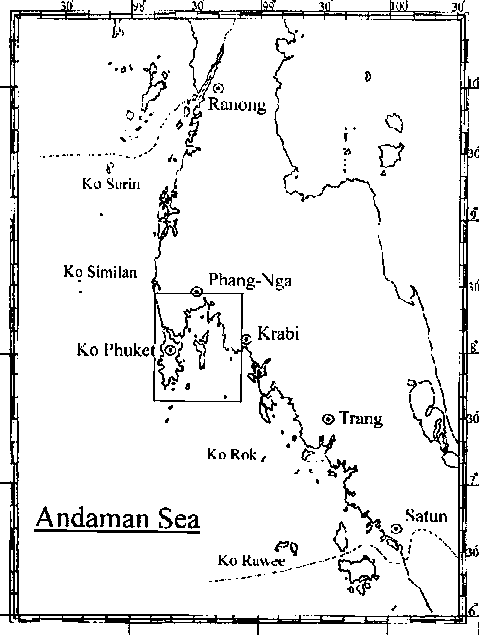The west coast of Thailand stretches along the Andaman Sea with 740 km of coastline (Menasveta 1997) and many islands (Figure 1). The shelf area covers about 126000 km2 (Chullasorn 1998). Inshore areas within three kilometres have an average depth of about three metres. Large mangrove forests are the main habitat structure along that coast (Satapoomin 1997). Only a few islands are girdled with coral reefs and protected as national marine parks.
Figure 1: The west coast of Thailand. The square covers the Phang-nga bay, the area investigated.

The sea floor of the inshore areas is dominated by soft bottom substrates composed of mud and sand in variable mixtures. Parts of it are also covered with seagrass. Chansang & Poovachiranon (1994) identified 10 different species of seagrass along the Andaman Sea coast and classified three different types of seagrass beds, species-rich habitats linked with sandy and muddy shallow waters.
The coastal waters are rich in nutrients and two sources for these nutrients have been identified. The northern part, from Ranong to Phuket provinces, is influenced by deep-sea upwelling processes of nutrient-rich deep-sea water, whereas the waters in the southern part are influenced by surface water runoffs transporting nutrient-rich freshwater into the coastal areas (Janecarn & Chullasorn 1997, Limpsaichol et al. 1998, Sundström et alUS$ 1987).
The combination of such habitats, the soft structure of the seafloor and the input of nutrients have created rich and diverse aquatic resources. A recent study on the fish fauna in the mangrove areas and the seagrass beds showed that these habitats were occupied by 280 fish species, 179 of which were restricted to a single habitat (Satapoomin 1997). A large variety of shrimp, such as Penaeus spp., Metapenaeus spp., Parapeneopsis spp., Metaparapeneopsis spp., Trachypeneopsis spp., Solenocera spp. and Heterocarpus spp., were also found as well as several types of crabs and many mollusc species. These nutrient-rich and diverse environments have led to the development of successful small-scale and commercial fisheries. In 1996 a total of 827390 tons of fish and shellfish were caught along the Andaman Sea coast, which is about 29 percent of the total marine production of Thailand (FAO 1998a).
The data in the present study were collected in the Phang-nga bay. They were used to calculate the total catch of certain types of gear and the value of small-scale fishery along the coast. The data are used to estimate the socio-economic impact of small-scale fishery along the coast.
The bay of Phang-nga itself covers an area of about 3000 km2, with mangrove scattered over 1900 km2 (Chantawong in press) and 67 islands. About 700 km2 of nearshore areas in the north have an average depth of less than five metres and the maximum depth in the bay is about 30 metres (Limpsaichol et al. 1998). Therefore, most of the bay area can be used for fishing either by small-scale fishermen or by commercial fisheries.
The bay has become the main target for marine research, especially fishery research, because the Phuket Marine Biological Centre and the Andaman Sea Fisheries Development Centre are on Phuket Island. Much fishery data have been collected in this area since 1970. These will be combined with newly collected data from the bay to give a better overview of the small-scale fishery situation along the Andaman Sea coast.